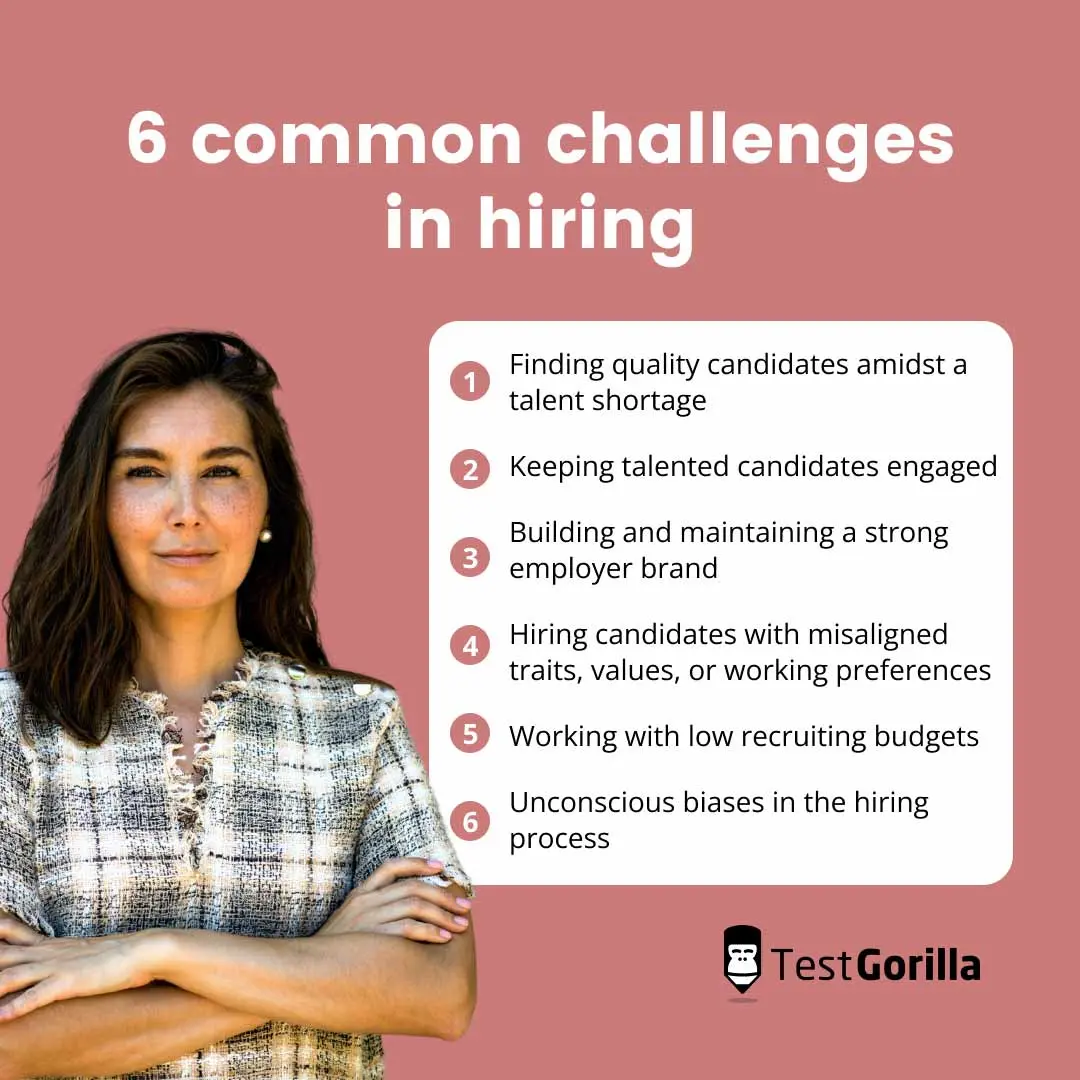In the aftermath of the COVID-19 pandemic, companies have seen significant changes in the labor market – from talent shortages and skills gaps to the introduction of flexible and remote working.
These changes and more, have made it increasingly difficult to source, engage, and hire quality candidates, leaving many companies understaffed and unable to meet business demands.
However, recruiters who’ve adapted their hiring processes to the changing times have emerged as winners in the war for talent.
To achieve this success, it’s first important to understand the hiring challenges that define the current landscape.
In this guide, we look at 6 common challenges in hiring employees today. We also share our top tips for overcoming these challenges so you can get ahead of competitors and hire the best candidates in the job market.
Table of contents
- 6 common challenges in hiring and how to overcome them
- 1. Finding quality candidates amidst a talent shortage
- 2. Keeping talented candidates engaged
- 3. Building and maintaining a strong employer brand
- 4. Hiring candidates with misaligned traits, values, or working preferences
- 5. Working with low recruiting budgets
- 6. Unconscious biases in the hiring process
- Hire faster and better with TestGorilla
6 common challenges in hiring and how to overcome them
1. Finding quality candidates amidst a talent shortage
Problem
Technology is growing at lightning speed leading to constant changes in what employers are looking for. For example, many companies are now looking for candidates who are skilled at using and optimizing AI, such as ChatGPT.
However, at the current rate of change, the talent pool can’t keep up and hasn’t had time to prepare and upskill. There is, therefore, a disparity between the skills needed for businesses to thrive and the number of candidates who possess these skills.
In addition to this, there’s been an overall decrease in labor force participation rates. This means less of the working-age population is employed or actively looking for work – further exacerbating the problem.
Solution
Paying above-market wages or offering health insurance and/or retirement benefits are great ways to attract a higher number of skilled applicants. If you don’t have the budget for this, today’s workers also appreciate perks such as flexible working, more paid time off, and so on.
In addition to quantity, you also need to attract applicants with the right skillsets for your open roles. One way to do this is to ensure that each job description is specific about what the role is and what qualifications and skills it requires.
Additionally, it’s beneficial to put applicants through pre-employment screening tests before interviewing them. This way, you can efficiently weed out the candidates who don’t possess the job-specific skills required for the role, and progress those who do.
Similarly, you can identify those who may not possess the required skills yet, but demonstrate an aptitude for the role by performing well on cognitive ability tests, such as TestGorilla’s Critical Thinking skills or Problem Solving test.
Finally, you can also consider upskilling or re-skilling your existing workforce to bridge key skills and knowledge gaps in your company without hiring externally – a phenomenon called “quiet hiring.” But, be careful not to leave your company understaffed and your workforce overloaded.
2. Keeping talented candidates engaged
Problem
In addition to finding skilled or talented candidates, you also need to keep them engaged. Top candidates are often contacted by multiple recruiters at the same time and the very best ones may even have several job offers to choose from.
Further, many applicants apply for roles without being sure they really want to move to another company. You can spend a lot of time and effort in sourcing an excellent applicant who’s a perfect fit for the job only to lose them to cold feet.
Solution
There are several steps you can take to keep talented candidates engaged, including those who have passively applied for roles. The most important step is staying connected with them through their application process.
It’s necessary to manage your candidates’ expectations about when they can expect to hear from you and stick to the timelines. Long wait times and gaps in communication are key reasons candidates lose interest in a company.
Pre-employment screening platforms, like TestGorilla, make it easy to keep in touch with candidates, with an automated email system and the ability to share test results. Candidates can be kept in the loop and maintain interest in the hiring process.
Personality testing is another powerful tool to keep your applicants engaged. Roll out personality tests such as the Enneagram, Big Five (OCEAN), and DISC during the early stages of the application process.
These tests are not only interesting to take but also give you valuable insights about candidates’ traits, attributes, and values. You can tailor interview questions and your communications with candidates based on their personality types and motivations, giving you an edge over other recruiters.
3. Building and maintaining a strong employer brand
Problem
Building a strong employer brand during the hiring process is essential to attracting good candidates. But, today’s candidates are quick to leave public reviews and feedback on social media and websites such as Glassdoor. Even small mistakes can leave you with negative employer ratings and tarnish your reputation in the job market.
Moreover, building a robust employer brand is complex, effortful, and time-consuming. You need to carefully craft a consistent employer image across every touchpoint applicants have with you – from your careers website to the application process and even social media.
Solution
Create a positive candidate experience for every applicant who applies for a role within your company. You can do this by communicating frequently, effectively, and transparently.
Small initiatives such as notifying your candidates of their test results, keeping them informed as they progress through the different hiring stages, or respectfully rejecting non-selected candidates rather than keeping them waiting, also foster a positive experience and enhance your company’s professionalism.
Further, provide candidates with an easy and seamless hiring experience. Use an intuitive and user-friendly prescreening platform that offers tests, assessments, and branded one-way video interviews that can be completed and recorded at the candidates’ convenience.
It’s also vital to establish a good employer brand for future applicants. Craft a compelling employee value proposition (EVP) that defines why your company is a great place to work, touching on company values and employee benefits. Include these points clearly on your careers website and each role description.
Showcase your company’s culture, mission, and values consistently across various channels such as social media, industry events, college assessment days, and so on. Using employee ambassadors or testimonials is also a great way to build a good reputation in the job market.
4. Hiring candidates with misaligned traits, values, or working preferences
Problem
Hiring teams often find themselves in scenarios where highly skilled employees end up underperforming and eventually parting ways with the company. Even the most skilled or qualified candidates can fail in their roles if they don’t mesh well with the company’s culture or people.
Not only does this disrupt productivity but you also waste company resources hiring, onboarding, and training the wrong person to lose them and have to start all over.
Recommended reading: The unseen, personal costs of mis-hires (and what you can do about them)
Solution
Be specific about what the role or company requires from the candidate in the job description. For instance, let candidates know what traits they need for the role, whether it be resilience, charisma, and so on.
TestGorilla’s Culture-Add test is an effective way to assess if your candidates’ traits and characteristics are aligned with the culture of the organization. In fact, questions can be customized to test candidates specifically on your company’s values, role-specific attributes, and more, based on a questionnaire that you complete in advance.
Furthermore, in addition to personality and culture-add testing, behavioral interviews also offer robust insights into candidates’ attributes and how they’ll think and act in different scenarios in the future.
5. Working with low recruiting budgets
Problem
With an economic recession looming, most companies are trying to cut back on costs. This means recruiters are often working with low hiring budgets, making it all the more challenging to hire and engage the best candidates.
Solution
Using pre-employment screening software helps reduce your costs in two ways. Firstly, online testing is cost-effective, convenient, and efficient. Candidates can take prescreening tests and participate in one-way video interviews from anywhere, saving company resources.
Secondly, pre-employment testing also speeds up your hiring process by providing you with quick results that you can use to make faster decisions. This helps to save on unnecessary expenses and fill vacant positions that are costly and disruptive to business operations.
Look for pre-employment screening platforms that cater to businesses of all sizes and budgets. TestGorilla offers multiple different pricing plans – including a free plan and affordable paid plans based on your testing needs and company size.
6. Unconscious biases in the hiring process
Problem
Today’s employers want to hire a diverse set of candidates and make job offers that are fair and equal. Despite this, there are huge gaps in most companies’ Diversity, Equity, and Inclusion (DEI) numbers.
Poor DEI damages your company’s reputation and also puts you at legal risk for not providing equal opportunities. The problem often arises as early as the hiring process which is particularly susceptible to unconscious biases.
Solution
You need to make a conscious effort to promote fair hiring practices. The key to this is to stop relying on processes such as traditional resume screening and interviews which are riddled with human decision-making biases.
Pre-employment testing platforms, such as TestGorilla, promote data-driven bias-free hiring, focusing on skills testing. You can build a tailor-made assessment relevant to the requirements of your open position to gain objective data and shortlist suitable candidates without human intervention.
It’s also important to ensure that all hiring managers and recruiters receive regular unconscious bias training. This is a great way to remind them of potential prejudices in hiring and how to overcome them.
Following these practices can help you build a diverse and inclusive workplace. It’s also appealing to future candidates who will view your company as fair and meritocratic.
Hire faster and better with TestGorilla
Today’s recruiters are faced with a war for talent. They’re dealing with skills shortages, low recruiting budgets, and poor candidate engagement, to name a few problems.
On top of this, they still need to find and hire the best talent, build a strong employer brand, promote diversity, and ensure they stand out as reputed employers in the job market.
Pre-employment testing software, like TestGorilla, helps you to source quality candidates, keep them engaged, check for job and culture fit, save time and money, and promote fair hiring practices.
TestGorilla’s extensive test library offers job-specific skills tests, personality and culture-add assessments, cognitive ability tests, and many other tools to help you make better hiring decisions.
Sign up for a free plan, take a product tour, or schedule a free 30-minute live demo today to hire better, faster, and stay ahead of the curve.
Related posts
Hire the best candidates with TestGorilla
Create pre-employment assessments in minutes to screen candidates, save time, and hire the best talent.
Latest posts
The best advice in pre-employment testing, in your inbox.
No spam. Unsubscribe at any time.

Hire the best. No bias. No stress.
Our screening tests identify the best candidates and make your hiring decisions faster, easier, and bias-free.
Free resources
This checklist covers key features you should look for when choosing a skills testing platform
This resource will help you develop an onboarding checklist for new hires.
How to assess your candidates' attention to detail.
Learn how to get human resources certified through HRCI or SHRM.
Learn how you can improve the level of talent at your company.
Learn how CapitalT reduced hiring bias with online skills assessments.
Learn how to make the resume process more efficient and more effective.
Improve your hiring strategy with these 7 critical recruitment metrics.
Learn how Sukhi decreased time spent reviewing resumes by 83%!
Hire more efficiently with these hacks that 99% of recruiters aren't using.
Make a business case for diversity and inclusion initiatives with this data.


















